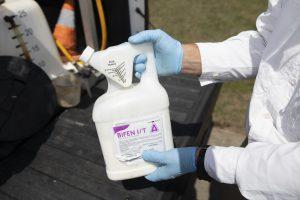Hello Avid Readers! Have you ever wondered, What is pesticide drift and how do I prevent it? When pesticides move away from their intended site they can cause environmental, health, and legal concerns. This and other factors make it important for pesticide applicators, whether in a home garden or a 500 acre farm, to understand what drift is and how to prevent it.
Pesticide Drift
Pesticide drift refers to the unintentional movement of pesticides in the air from the intended area to surrounding areas and objects. There are several types of pesticide drift.
- Spray- small droplets of pesticide are carried by wind beyond the target area
- Vapor- pesticides have turned into vapor and moved out of the target area
- Particle (Dust)- pesticide dusts or powders are carried by the wind into non-target areas
Why Are People Concerned?
Pesticide drift can cause health consequences for people who come in contact with the pesticide especially if they are unaware of the application and experience direct exposure to the pesticide. It may also affect non-target plants, insects, or animals. Crop damage from neighbors has been a hot topic in recent years. In Florida, there can be legal consequences or penalties for damage caused to neighboring farms’ crops by certain types of herbicides. Finally, non-targets like bees, butterflies, and natural habitats are at risk if drift is not carefully managed.

How can I Prevent Pesticide Drift?
The extent and impact of pesticide drift depend on the applicator, the pesticide, the weather conditions, and application methods. There are many ways drift can be prevented although in some cases it cannot be eliminated entirely.
Applicators of Restricted Use Pesticides or RUPs should have gone through training to become certified applicators in the state of Florida. The training would have included many of the following pieces of information.
Read the Label
If you work with pesticides you will hear over and over again that you must read the label. It is a legal contract that you are agreeing to when you decide to use that product. We have a series of blogs on how to read a label.

Monitor the Weather
During large-scale operations, wind speed should be below 10 mph. Applicators should ensure wind direction will not carry particles into sensitive areas, and watch out for temperature inversions. Avoid spraying when relative humidity is below 50% and temperatures are high.
More and more of us homeowners are leaving areas of our yards in a natural state to feed pollinators. Make sure if you are clearing up what you see as weeds on your property that you don’t kill your neighbors’ “flowers”. Have a look at the weather before you go out to spray. If it is windy or very hot and humid just hold off a bit. Early morning and later in the evening are better times for applications.
Select the most Appropriate Equipment
It is very important to select the best nozzle type and size for each type of application. Larger droplets are less likely to drift. There are also drift reduction nozzles available. Nozzles are a lot cheaper than a lawsuit or lost crops, change them out as needed.
If working at home it is likely you’ve selected a Ready-To-Use product from the store. This will decrease the need for any equipment selection. Just make sure to follow the label for things like when to turn on the hose!

Calibrate the Equipment
Make sure the equipment is producing the correct spray pattern and droplet distribution. If you are unsure of how to calibrate your machine or have questions reach out to the PIO or your county extension agent, we can help!
Create Buffer Zones
Whether it is between one farm, one field, or you and your neighbors, it’s not a bad idea to leave an area unsprayed as a buffer. This way if the wind gusts or a little drift does occur, the consequences are minimized.
Pesticide Selection
Some pesticides allow for higher carrier rates. This can allow for the use of larger nozzles which will produce larger, and less drifty, droplets. There are also “low-volatile” formulations. These will reduce the risk of vapor drift.
Those of us working at home don’t have as many choices when it comes to types of products. The other tips here are more applicable to lawns and gardens.

Communication and Awareness
When growers get together and communicate there is a better chance they will be able to make an integrated plan together to prevent drifting into each other’s sensitive areas. Talk to your neighbors or any relevant stakeholders about what your plans are. If needed they may be able to cover any especially sensitive crops or borders when you are making your application.
When working in your yards make sure to be informed so if your neighbor has a concern you are ready to provide them with the facts. Knowing what you are using, how to use it, and what if any concerns are associated with the product can help alleviate their concerns.
Summary
Pesticide drift occurs when the pesticide is carried by the air into an unintended area. It is concerning as there can be human health, environmental health, and legal and monetary consequences. Lucky for us, it can also be prevented! the tips and tricks above will all help reduce the potential for pesticide drift. Although many might wish for, A World Without Pesticides, they are a vital component of pest management and aren’t going anywhere anytime soon. Our best course of action is to be educated on their safe use.
Additional Resources
SUBSCRIBE
 0
0
